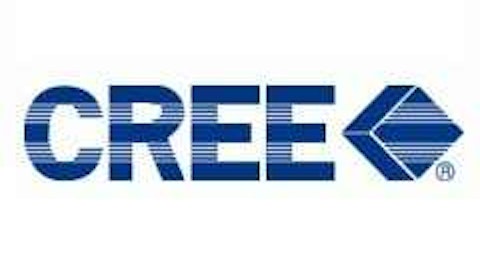Cree, Inc. (NASDAQ:CREE) is the leader in light emitting diodes (LEDs), semiconductor solutions and LED lighting. The LED industry trend thus far has not been favorable with falling prices and rising competition. In contrast, CREE reported a 14% and 69% growth in revenue and net profit, respectively, during the last quarter. Furthermore, the company also managed to increase its gross margins by 4% by reducing production costs.

The announcement of new, revolutionary LED bulbs by Cree, Inc. (NASDAQ:CREE) caused stock prices to increase by 17% during the first week of March. The competitively positioned bulbs cost only $10 and consume 84% less electricity than traditional bulbs. Initially, the revenue outlook for Q3 fiscal 2013 wasn’t very optimistic. Nonetheless, it was later revised with higher revenue estimates. I believe in the long-term growth of the LED market. However, there may be a high premium associated with Cree, Inc. (NASDAQ:CREE)’s present share value. Here is why I think there may be a downside to its stock price in the near term.
LED market size
The LED market has grown significantly over the past five years. During 2008, the global LED market size was close to $5 billion. However, by the end of 2012, it grew past $14 billion. According to Trefis, if LEDs manage deeper penetration in the general lighting segment by offering cheaper products, then the global market size may reach $26 billion over the next seven years.
Any appreciation in Cree, Inc. (NASDAQ:CREE)’s stock price will be directly related to the global adoption rate of LEDs. If the market size exceeds all expectations and grows past $30 billion, there may be a strong upside to the stock price. Nonetheless, if the market size hovers around the $20 billion mark, then Cree might struggle to report any consistent growth. Hence, we may even witness a heavy selling of its stock.
Sluggish LED adoption rate
Since the current LED market is swamped with a wide variety of products, investors should expect a dip in prices. Cree, Inc. (NASDAQ:CREE)’s revised revenue outlook was underpinned by highly differentiated value-for-money products. Currently, Cree has a 10% market share both in outdoor lighting and the industrial segment. In contrast, the residential segment, which offers maximum growth opportunities, still remains underpenetrated for Cree, since it only possesses 1% market share.
Rapid LED adoption is extremely challenging. It has a high initial cost, which makes market penetration in emerging economies a daunting task. The awareness of LEDs’ environmental advantages is still growing at a very sluggish pace, so total adoption of LEDs will largely depend upon how intensely governments get involved in promoting them.
Gross margins to remain below historic levels
Cree, Inc. (NASDAQ:CREE) reported a gross margin of 49.5% during 2010. However, 2011 saw gross margins drop to approximately 39%. The decline was predominantly due to increasing R&D costs and a fall in sale prices. Nonetheless, 2012 once again saw an increase in gross margins due to enhanced utilization of production capacity.
Going forward, margins are expected to stay below historic levels; Cree’s production costs are low, but it’s offsetting those potential savings by also investing in its own business. Amid higher revenue estimates, Cree also revised its operating-cost outlook, with plans to devote more cash to marketing and R&D.
I expect the growing awareness for LEDs to drive demand for Cree. Nonetheless, in the given environment, demand for low-margin products from emerging markets should keep margins under pressure.
Increasing competition in the LED market
Cree primarily competes with a fully owned subsidiary of Siemens AG (ADR) called Osram, and Philips within the LED space. Osram reported total revenue of €5.4 billion during 2012. The company designs and manufactures LEDs and has a presence throughout North America. It’s one of the largest manufacturers for optoelectronic semiconductors, and it claims the highest market share in the North American general lighting segment.
Likewise, Philips also has strong presence in the LED market. Similar to Cree, it also offers a 12-watt “ENDURALED” light bulb that consumes 80% lesser energy than a regular bulb and lasts 25 times longer. The LED bulbs were launched in the U.S. during 2010, and priced in the $40 to $50 range. Philips recently announced that it will introduce a new $10 LED bulb by the end of this year, which will replace the most commonly used 60 watt-incandescent. Philips has a market cap of €22 billion and reported a total revenue of €25 billion during fiscal 2012.
Can LED market growth be leveraged?
The growth potential in the global LED market still remains extremely high. Cree reported 12% growth in LED sales during the last quarter, in addition to the LED Chips and Lighting Components division, which reported 28% year-over-year growth.
Cree has manufacturing facilities both in China and North America, which makes it well-equipped to deal with increasing demand for LED products. However, the recent rally in the stock price was underpinned by the previous quarter’s results. Going forward, Cree’s margins are expected to remain under pressure, predominantly due to increasing R&D, marketing cost and increasing competition.
As new companies and products enter the market, the prices of energy-saving LED products are dropping consistently. In order to remain competitive with low gross margins, Cree must increase its market share.
The article 1 Strategy This LED Stock Must Pursue originally appeared on Fool.com and is written by Ashit Gulati.
Copyright © 1995 – 2013 The Motley Fool, LLC. All rights reserved. The Motley Fool has a disclosure policy.

